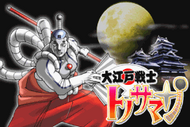| This article contains information about Ace Attorney media that has been released only in Japan. | |
|---|---|
|
The information in this article comes from a game, demo, or other media that has been released in Japan, but not in any predominantly English-speaking country. The subject of this article has not been officially revealed for English versions of this media. English versions of this content are only available through unofficial translations. More information on this can be found here. If you have personal experience with the item of media in question, you can help the Ace Attorney Wiki by improving on this article. Please heed the manual of style when adding information. | |
| We need more pieces to finish this puzzle. | |
|---|---|

|
This article is under construction. While it is not short, it still needs expansion as outlined in the manual of style. The article most likely needs expansion near the end of the tagged section or sections. |
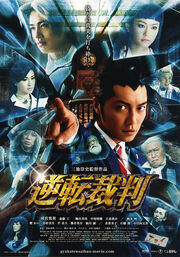
Film poster.
Gyakuten Saiban (逆転裁判 Turnabout Trial), also known as "Ace Attorney", is a Japanese courtroom drama film based on Capcom's Ace Attorney series, specifically the first game Phoenix Wright: Ace Attorney. The film uses the video game series' signature style and was directed by Takashi Miike.[1] The film stars Hiroshige Narimiya as the defense attorney Ryūichi Naruhodō (Phoenix Wright), Mirei Kiritani as the spirit medium Mayoi Ayasato (Maya Fey), and Takumi Saito as the prosecutor Reiji Mitsurugi (Miles Edgeworth).
The film was given a cinema release in Japan on February 11, 2012.[2], but screened at the International Film Festival Rotterdam before that.[3] Miike stated plans for an international release, and the movie premiered in the United States at the 2012 AM² anime convention in June 2012.[4]
The screenplay was written by Takeshi Iida and Sachiko Oguchi, with music by Koji Endo. The Japanese male rock band Porno Graffitti provide the film's main theme song ("2012Spark").
Premise

The logo for the Gyakuten Saiban film.
Based primarily on the first game in the series, Phoenix Wright: Ace Attorney, the film focuses on rookie defense attorney Ryūichi Naruhodō (Phoenix Wright), as he strives to protect his clients in various murder trials, including the death of his mentor, Chihiro Ayasato (Mia Fey), and the accusation of rival prosecutor, Reiji Mitsurugi (Miles Edgeworth). Naruhodō's greatest ally is Chihiro's younger sister Mayoi (Maya Fey), a spirit medium whose body is posessed by Chihiro to communicate with him. As well as the supernatural, sci-fi elements are also used, including attorneys bringing up projected images of evidence during trials as a representation of the in-game court record.
Cast
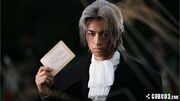
Takumi Saito as Reiji Mitsurugi/Miles Edgeworth.
- Ryuichi Naruhodou (Phoenix Wright) - Hiroshige Narimiya
- Reiji Mitsurugi (Miles Edgeworth) - Takumi Saito
- Mayoi Ayasato (Maya Fey) - Mirei Kiritani
- Masashi Yahari (Larry Butz) - Akiyoshi Nakao
- Keisuke Itonokogiri (Dick Gumshoe) - Shunsuke Daito
- Saibancho (the judge) - Akira Emoto
- Chihiro Ayasato (Mia Fey) - Rei Dan
- Natsumi Oosawagi (Lotta Hart) - Mitsuki Tanimura
- Shin Mitsurugi (Gregory Edgeworth) - Takehiro Hira
- Yukio Namakura (Robert Hammond) - Eisuke Sasai
- Masaru Konaka (Redd White) - Makoto Ayukawa
- Maiko Ayasato (Misty Fey) - Kimiko Yo
- Gou Karuma (Manfred von Karma) - Ryo Ishibashi
- Koutarou Haine (Yanni Yogi) - Fumiyo Kohinata
- Hoshio Yamano (Frank Sahwit) - Ayumu Saitô
- Sakura Himegami (Dee Vasquez) - Miho Ninagawa
- Takefumi Auchi (Winston Payne) - Seminosuke Murasugi
- Young Mayoi Ayasato (young Maya Fey) - ?
- Young Chihiro Ayasato (young Mia Fey) - Minami Hamabe
- Sayuri (Polly Jenkins) - Yuko Nakamura
- Sayuri (Polly the parrot) - ?
- Taiho-kun (Blue Badger) - ?
- Shingo Outorou (Matt Engarde)? - ?
- Kirio Kamiya (Adrian Andrews)? - ?
Differences from the Phoenix Wright: Ace Attorney video game
General differences

The courtroom machine.
- Spirits summoned via the Kurain Channeling Technique do not seem to be visible to everyone.
- A human-sized Blue Badger constantly follow police officers around and helps them with various tasks.
- A giant machine is concealed in the court's ceiling that can display interactive holograms, analyze evidence thrown into the air, and throw confetti after a non-guilty verdict. Sometimes the court's janitors are instead the ones throwing confetti while cleaning the floor from a previous trial.
- The film Miles Edgeworth appears to have a preference for the Jammin' Ninja (instead of being a secret fan of the Steel Samurai like he is in the games).
- Trials in the film are seen as more of a "sport" or "attraction", where anyone can purchase tickets to see the trial. It also appears that to see a whole trial, three separate tickets are required (corresponding to the bench trials in the games having a limit of three days).
- The only characters who show a similar breakdown to those in the games are Frank Sahwit and Winston Payne.
- The presiding judge for the majority of the movie is far more calm and collected than his, at times, rather comical video game counterpart.
- Maya and Gumshoe, while still having goofy moments, are more reserved and serious than their game counterparts.
The First Turnabout
- A judge different from the other cases is assigned to the trial.
- The courtroom used in this trial is different from the other cases.
- The murder weapon is no longer a clock made in the image of The Thinker.
- Mia Fey is the one who presents Cindy Stone's passport as evidence to prove Larry Butz's innocence.
- Instead of only making two copies of The Thinker, one for Butz and one for Cindy Stone, in the movie Butz sells copies of The Thinker at his Gourd Lake shop.
Turnabout Sisters
- April May, the Bellboy, and Marvin Grossberg are never seen or mentioned.
- Larry Butz, who wasn't present during the original episode in the game, is seen during the Turnabout Sisters part of the film.
- Detective Gumshoe does not mess up the order of his testimony, instead mentioning the dying message first.
- Redd White is a completely different character in appearance, personality, and profession. In the game, he is a smug, confident, and powerful businessman who blackmails various important figures. In the film, he has medium-length black hair and sports a black trenchcoat with sunglasses. He also breaks out a megaphone at one point when he loses his temper towards Wright. The film version is eventually revealed to be a former investigator of the DL-6 Incident, who has been manipulated by von Karma. He later dies of poisoning while in detention.
- The evidence hidden in The Thinker is the bullet from the DL-6 Incident (rather than evidence of White's blackmailing), which White fails to steal.
Turnabout Samurai
- The case occurs before Mia Fey's murder and doesn't involve Wright or Maya Fey at all. It is instead presented as an introduction to Miles Edgeworth as he finds Dee Vasquez guilty.
- The attorney of this case in the movie, is not Phoenix Wright.
- Dee Vasquez acts more crazed and flustered than in the game.
- Penny Nichols, Wendy Oldbag and Will Powers was never mentioned or shown in the movie.
- Sal Manella, while his name was not mentioned and he was not shown, was referred as the 'scipt writer' in the movie.
- Global Studios was not shown in the movie.
Turnabout Goodbyes
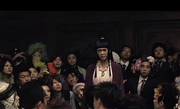
Maya speaking out during Lotta Hart's testimony.
- Butz's Steel Samurai balloon is much larger than in the game.
- Butz is not dressed as Santa Claus like he is in the game.
- The stolen money that is at the center of the class trial does not belong to Miles Edgeworth, but to another student entirely. Additionally, Edgeworth does not figure out that Butz is the thief until after von Karma is arrested.
- While Maya sets off Lotta Hart's camera with a party popper and a sneezing fit in the game, it is not even triggered by Maya's shouting in the movie.
- Hart's camera takes three photos instead of two. Because the camera is set up to take a single picture instead of an entire roll, the additional photo is from the second gunshot that occurred during Miles Edgeworth's meeting on the boat.
- Hart doesn't lie about taking pictures of Gourdy, nor does she make up the excuse that she was taking photographs of a meteor shower.
- Maya is not detained after her outburst during Hart's testimony.
- Wright and Maya's first visit to the caretaker's shack never occurs, including Polly's revelation of Yanni Yogi's link with the DL-6 Incident.
- The caretaker's shack itself is wildly different in appearance, and is in extremely poor condition.
- Yogi does not pretend to constantly doze off during conversations.
- While in the game Wright and Maya found the Gas Tank which Butz used to inflate the Steel Samurai Balloon, in the movie, Butz found the Steel Samurai balloon still attached to the Gas Tank in the lake.
- The radio DJ that Butz was listening to during the murder was an older man, rather than a woman.
- The stun gun attack occurs inside the caretaker's shack immediately after the discovery of Manfred von Karma's instructions by Wright and Maya. The circumstances behind the attack allows the attacker, von Karma, to conceal his identity as the mastermind until Wright's accusation.
- Manfred Von Karna is shot in the left shoulder, instead of the right.
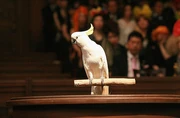
Polly.
- Polly is a Sulphur-crested Cockatoo instead of resembling a Scarlet Macaw like she does in the game.
- Polly's testimony is extended to include her owner's name, since the circumstantial evidence does not convince the judge of a pattern.
- The letter containing the murder instructions are printed instead of being handwritten, and also include a bottle of acid which Yanni Yogi uses to burn his fingerprints off.
- Yogi sees his wife's ghost after his confession. He is the only one to notice her.
- Although The Thinker was not seen again after the second episode in the game, it was brought again into the courtroom in the movie, which led to the discovery of the second bullet..
- During the discovery of what happened to the second bullet, Maya actually channels Mia.
- The metal detector is provided by Butz instead of Detective Dick Gumshoe.
- The DL-6 Incident occurs in the Records Room instead of the courthouse's elevator. This causes Miles Edgeworth to believe that his father was the one forging evidence, instead of von Karma. The truth is only revealed when Wright compares the second bullet from the DL-6 Incident with the forged evidence that triggered it.
- While Polly Jenkins was Yanni Yogi's fiancé in the game, she was his wife in the movie adaptation.
- Yanni Yogi's house was vandalized by people in the movie. However, the vandalization of his house was not mentioned in the game.
- Wright mentions that he plans on defending Yogi in court.
Rise from the Ashes
- The events of Rise from the Ashes are not mentioned or shown.
References to other cases
- There are multiple references to Farewell, My Turnabout at the very end of the movie. Butz's Gourd Lake shop and merchandise are re-branded to that of the Jammin' Ninja. A trial is also seen with Wright as the defense attorney, Edgeworth holding the Jammin' Ninja's signature bright red guitar, and with a witness appearing to be Matt Engarde (albeit wearing a different outfit). A woman resembling Adrian Andrews can also be seen when said witness first appears.
- The film's arranged version of Objection! 2001 contains a section that is a slower version of "Apollo Justice ~ A New Chapter of Trials!". The section is question plays during von Karma's arrest in the film and can be listened to here.
Cameo appearances
- The film's director, Takashi Miike, as a court spectator.
- Shu Takumi, creator of the Ace Attorney series, can be seen during the fourth case celebrating with Larry Butz.
Soundtrack
The film's music was composed by Kōji Endō, known for scoring other films by Takashi Miike. For the soundtrack, Endō chose to utilize various themes by Masakazu Sugimori from the original video game and re-arranged them for a musical ensemble consisting of strings, oboe, clarinet, horn, trumpet, and a choir. Additional background music was also newly composed in this manner. The soundtrack was later released on CD to tie in with the movie.[5] The film's theme song, "2012 Spark", was composed and performed by the Japanese male rock group Porno Graffitti.[6]
| Ace Attorney Movie Original Soundtrack | ||||||||||
|---|---|---|---|---|---|---|---|---|---|---|
| No. | Title | Length | ||||||||
| 1. | Ace Attorney - Trial (Cinema Ver.) | 0:44 | ||||||||
| 2. | Phoenix Wright ~ Objection 2001 (Cinema Ver.) | 3:34 | ||||||||
| 3. | Cross Examination ~ Allegro 2001 (Cinema Ver.) | 3:22 | ||||||||
| 4. | Negligence | 2:03 | ||||||||
| 5. | Attachment Order | 1:08 | ||||||||
| 6. | Breaking Into a Residence | 1:18 | ||||||||
| 7. | Imprisonment With Work | 1:11 | ||||||||
| 8. | Aggravated Escape | 0:55 | ||||||||
| 9. | Suspension of Execution of the Sentence | 1:19 | ||||||||
| 10. | Necessary Measure | 1:16 | ||||||||
| 11. | Evidence | 1:32 | ||||||||
| 12. | Testify Associate Judge | 1:27 | ||||||||
| 13. | Upper Instance Court | 1:10 | ||||||||
| 14. | Kidnapping | 1:23 | ||||||||
| 15. | Attempts | 0:46 | ||||||||
| 16. | Youth | 1:46 | ||||||||
| 17. | General Period for Payment | 1:14 | ||||||||
| 18. | Investigation ~ Core 2001 (Cinema Ver.) | 1:58 | ||||||||
| 19. | Maya Fey ~ Turnabout Sisters Theme 2001 (Diva Ver.) | 1:26 | ||||||||
| 20. | Pursuit ~ Cornered (Cinema Ver.) | 5:32 | ||||||||
| 21. | Fine | 2:18 | ||||||||
| 22. | Article 30 | 2:14 | ||||||||
| 23. | Neighboring Right | 2:24 | ||||||||
| 24. | Acceptance of Stolen Property | 1:39 | ||||||||
| 25. | Robbery | 0:50 | ||||||||
| 26. | Insults | 1:17 | ||||||||
| 27. | Gambling | 1:20 | ||||||||
| 28. | Arson of Inhabited Buildings | 1:40 | ||||||||
| 29. | Theft | 1:54 | ||||||||
| 30. | Obstruction to Flood Prevention | 0:46 | ||||||||
| 31. | Unjust Enrichment | 1:43 | ||||||||
| 32. | Fanfare | 1:11 | ||||||||
| 33. | BWV245 (BACH) | 2:38 | ||||||||
| 34. | The Steel Samurai (Cinema Ver.) | 1:22 | ||||||||
| 35. | Maya Fey ~ Turnabout Sisters Theme 2001 (Choir Ver.) | 2:35 | ||||||||
Total length: |
60:55 | |||||||||
Reception
The movie earned over US$1,547,000 in its opening weekend, grossing over US$6,145,000 during its theatrical run in Japan.[7] Richard Eisenbeis of Kotaku praised the movie, calling it "the best video game movie ever," and "on its own a fun, engaging mystery/comedy."[8] Paul Verhoeven of IGN gave the film a score of 8 out of 10, a "Great" rating, describing it as "explosive, high-camp melodrama, but it manages to work both as a legal thriller and a pitch-perfect adaptation of the game."[9] On the other hand, Jay Weissberg of Variety referred to the film as a "dull production" that was "criminally long and generally lacking in [Miike's] playful visual hyperbole."[10]
Home release
The film was released on DVD and Blu-ray on 22 August 2012, in Japan.[11] In Spain, the DVD and the Blu-Ray was released on 11 December 2012 in both Spanish and Japanese by the company Selecta Vision.[12] A German release of the DVD and Blu-ray is also planned in spring 2013.[13]
References
- ↑ 逆転裁判, eiga.com. Accessed on 2012-02-20.
- ↑ Opening Date Set For Ace Attorney Flick. Andriasang
- ↑ Ace Attorney, filmfestivalrotterdam.com. Accessed on 2012-02-20.
- ↑ AM² Announces US Premiere of the Manga Based Live Action Film Ace Attorney, am2con.org. Accessed on 2012-02-20.
- ↑ Gyakuten Saiban Movie Original Soundtrack, vgmdb.net, http://vgmdb.net/album/31912, retrieved 17 June 2012
- ↑ Porno Graffitti to Perform Ace Attorney Theme Song, animenewsnetwork.com, http://www.animenewsnetwork.com/interest/2011-10-27/porno-graffitti-to-perform-ace-attorney-theme-song, retrieved 17 June 2012
- ↑ http://www.boxofficemojo.com/movies/intl/?page=&country=JP&id=_fGYAKUTENSAIBANA01
- ↑ http://kotaku.com/5884541/ace-attorney-is-the-best-video-game-movie-ever-take-that-hollywood
- ↑ http://ign.com/articles/2012/08/09/ace-attorney-review
- ↑ Weissberg, Jay (29 January 2012), "Ace Attorney", Variety, http://www.variety.com/review/VE1117946959/, retrieved 27 April 2012
- ↑ http://honto.jp/netstore/pd-dvd_85096456.html http://honto.jp/netstore/pd-dvd_85096457.html
- ↑ PHOENIX WRIGHT ACE ATTORNEY BD + DVD, selecta-vision.com, http://www.selecta-vision.com/Home-Entertainment/Phoenix-Wright-Ace-Attorney-BD-DVD, retrieved 24 December 2012 2012
- ↑ Ace Attorney-Movie in Deutschland, animania.de, http://www.animania.de/news-single-home.html?&tx_ttnews%5Btt_news%5D=1508&tx_ttnews%5BbackPid%5D=7&cHash=f4412839ce, retrieved 16 June 2012
External links
| Content from Wikipedia | |
|---|---|
| This page uses Creative Commons Licensed content from Wikipedia (view authors). For more information on this licensing, visit the help page at the Community Central. | |

